shift SATURN ASTRA 2008 User Guide
[x] Cancel search | Manufacturer: SATURN, Model Year: 2008, Model line: ASTRA, Model: SATURN ASTRA 2008Pages: 304, PDF Size: 1.92 MB
Page 162 of 304
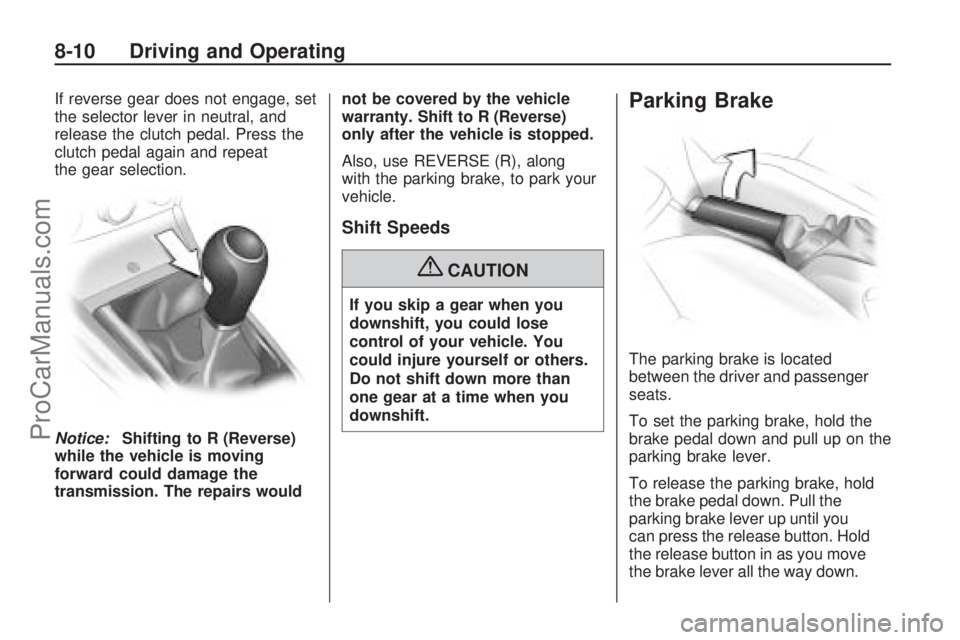
If reverse gear does not engage, set
the selector lever in neutral, and
release the clutch pedal. Press the
clutch pedal again and repeat
the gear selection.
Notice:Shifting to R (Reverse)
while the vehicle is moving
forward could damage the
transmission. The repairs wouldnot be covered by the vehicle
warranty. Shift to R (Reverse)
only after the vehicle is stopped.
Also, use REVERSE (R), along
with the parking brake, to park your
vehicle.
Shift Speeds
{CAUTION
If you skip a gear when you
downshift, you could lose
control of your vehicle. You
could injure yourself or others.
Do not shift down more than
one gear at a time when you
downshift.
Parking Brake
The parking brake is located
between the driver and passenger
seats.
To set the parking brake, hold the
brake pedal down and pull up on the
parking brake lever.
To release the parking brake, hold
the brake pedal down. Pull the
parking brake lever up until you
can press the release button. Hold
the release button in as you move
the brake lever all the way down.
8-10 Driving and Operating
ProCarManuals.com
Page 163 of 304
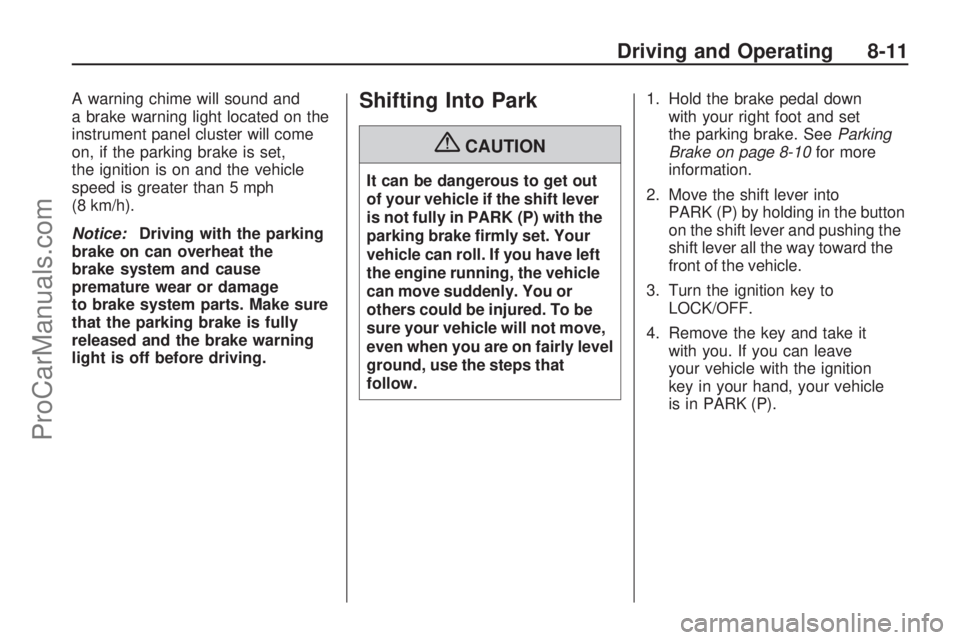
A warning chime will sound and
a brake warning light located on the
instrument panel cluster will come
on, if the parking brake is set,
the ignition is on and the vehicle
speed is greater than 5 mph
(8 km/h).
Notice:Driving with the parking
brake on can overheat the
brake system and cause
premature wear or damage
to brake system parts. Make sure
that the parking brake is fully
released and the brake warning
light is off before driving.Shifting Into Park
{CAUTION
It can be dangerous to get out
of your vehicle if the shift lever
is not fully in PARK (P) with the
parking brake �rmly set. Your
vehicle can roll. If you have left
the engine running, the vehicle
can move suddenly. You or
others could be injured. To be
sure your vehicle will not move,
even when you are on fairly level
ground, use the steps that
follow.1. Hold the brake pedal down
with your right foot and set
the parking brake. SeeParking
Brake on page 8-10for more
information.
2. Move the shift lever into
PARK (P) by holding in the button
on the shift lever and pushing the
shift lever all the way toward the
front of the vehicle.
3. Turn the ignition key to
LOCK/OFF.
4. Remove the key and take it
with you. If you can leave
your vehicle with the ignition
key in your hand, your vehicle
is in PARK (P).
Driving and Operating 8-11
ProCarManuals.com
Page 164 of 304

Leaving Your Vehicle with the
Engine Running
{CAUTION
It can be dangerous to leave the
vehicle with the engine running.
The vehicle could move
suddenly if the shift lever is not
fully in P (Park) with the parking
brake �rmly set. And, if you
leave the vehicle with the engine
running, it could overheat and
even catch �re. You or others
could be injured. Do not leave
the vehicle with the engine
running.If you have to leave your vehicle
with the engine running, be sure your
vehicle is in PARK (P) and your
parking brake is �rmly set before you
leave it. After you have moved the
shift lever into PARK (P), hold the
regular brake pedal down. Then, see
if you can move the shift lever away
from PARK (P) without �rst pushing
the button.
If you can, it means that the shift
lever was not fully locked in
PARK (P).
Torque Lock
If you are parking on a hill and you
do not shift your transmission into
PARK (P) properly, the weight of the
vehicle may put too much force on
the parking pawl in the transmission.
You may �nd it difficult to pull the
shift lever out of PARK (P).This is called torque lock. To prevent
torque lock, set the parking brake
and then shift into PARK (P) properly
before you leave the driver’s seat.
To �nd out how, seeShifting Into
Park on page 8-11.
When you are ready to drive, move
the shift lever out of PARK (P)before
you release the parking brake.
If torque lock does occur, you may
need to have another vehicle
push your vehicle a little uphill to
take some of the pressure from the
parking pawl in the transmission,
so you can pull the shift lever out of
PARK (P).
8-12 Driving and Operating
ProCarManuals.com
Page 165 of 304
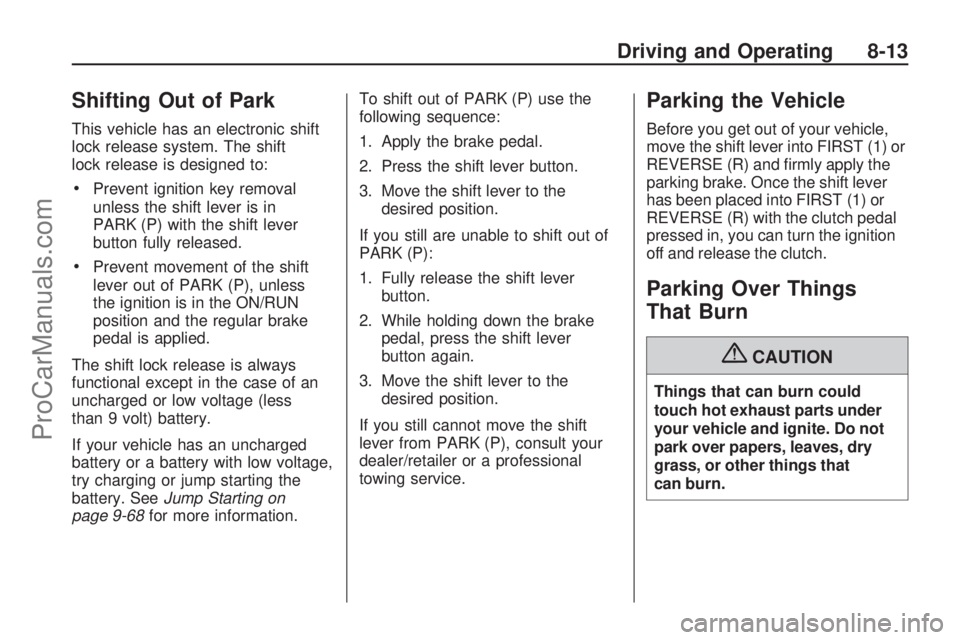
Shifting Out of Park
This vehicle has an electronic shift
lock release system. The shift
lock release is designed to:
Prevent ignition key removal
unless the shift lever is in
PARK (P) with the shift lever
button fully released.
Prevent movement of the shift
lever out of PARK (P), unless
the ignition is in the ON/RUN
position and the regular brake
pedal is applied.
The shift lock release is always
functional except in the case of an
uncharged or low voltage (less
than 9 volt) battery.
If your vehicle has an uncharged
battery or a battery with low voltage,
try charging or jump starting the
battery. SeeJump Starting on
page 9-68for more information.To shift out of PARK (P) use the
following sequence:
1. Apply the brake pedal.
2. Press the shift lever button.
3. Move the shift lever to the
desired position.
If you still are unable to shift out of
PARK (P):
1. Fully release the shift lever
button.
2. While holding down the brake
pedal, press the shift lever
button again.
3. Move the shift lever to the
desired position.
If you still cannot move the shift
lever from PARK (P), consult your
dealer/retailer or a professional
towing service.
Parking the Vehicle
Before you get out of your vehicle,
move the shift lever into FIRST (1) or
REVERSE (R) and �rmly apply the
parking brake. Once the shift lever
has been placed into FIRST (1) or
REVERSE (R) with the clutch pedal
pressed in, you can turn the ignition
off and release the clutch.
Parking Over Things
That Burn
{CAUTION
Things that can burn could
touch hot exhaust parts under
your vehicle and ignite. Do not
park over papers, leaves, dry
grass, or other things that
can burn.
Driving and Operating 8-13
ProCarManuals.com
Page 167 of 304

CAUTION (Continued)
Also, idling in a closed-in place
can let deadly carbon monoxide
(CO) into your vehicle even if the
climate control fan is at the
highest setting. One place
this can happen is a garage.
Exhaust — with CO — can come
in easily. NEVER park in a
garage with the engine running.
Also see “If You Are Caught in a
Blizzard” underWinter Driving
on page 8-27.
{CAUTION
It can be dangerous to get out
of your vehicle if the shift lever
is not fully in PARK (P) with the
parking brake �rmly set. Your
vehicle can roll. Do not leave
your vehicle when the engine
is running unless you have to.
If you have left the engine
running, the vehicle can move
suddenly. You or others could
be injured. To be sure your
(Continued)
CAUTION (Continued)
vehicle will not move, even
when you are on fairly level
ground, always set the parking
brake and move the shift lever
to PARK (P).
Follow the proper steps to be sure
your vehicle will not move. See
Shifting Into Park on page 8-11.
Driving and Operating 8-15
ProCarManuals.com
Page 176 of 304

If your vehicle starts to slide, ease
your foot off the accelerator pedal
and quickly steer the way you want
the vehicle to go. If you start steering
quickly enough, your vehicle may
straighten out. Always be ready for a
second skid if it occurs.
Of course, traction is reduced when
water, snow, ice, gravel, or other
material is on the road. For safety,
you want to slow down and
adjust your driving to these
conditions. It is important to slow
down on slippery surfaces because
stopping distance is longer and
vehicle control more limited.
While driving on a surface with
reduced traction, try your best to
avoid sudden steering, acceleration,
or braking, including reducing
vehicle speed by shifting to a lower
gear. Any sudden changes could
cause the tires to slide. You
might not realize the surface isslippery until your vehicle is
skidding. Learn to recognize warning
clues — such as enough water,
ice, or packed snow on the road to
make a mirrored surface — and
slow down when you have any
doubt.
Remember: Any Antilock Brake
System (ABS) helps avoid only the
braking skid.
Driving at Night
Night driving is more dangerous
than day driving because some
drivers are likely to be impaired — by
alcohol or drugs, with night vision
problems, or by fatigue.
Night driving tips include:
Drive defensively.
Do not drink and drive.
Reduce headlamp glare by
adjusting the inside rearview
mirror.
Slow down and keep more space
between you and other vehicles
because headlamps can only
light up so much road ahead.
Watch for animals.
When tired, pull off the road.
Do not wear sunglasses.
Avoid staring directly into
approaching headlamps.
Keep the windshield and all glass
on your vehicle clean — inside
and out.
Keep your eyes moving,
especially during turns or curves.
No one can see as well at night as
in the daytime. But, as we get
older, these differences increase.
A 50-year-old driver might need
at least twice as much light to see
the same thing at night as a
20-year-old.
8-24 Driving and Operating
ProCarManuals.com
Page 178 of 304
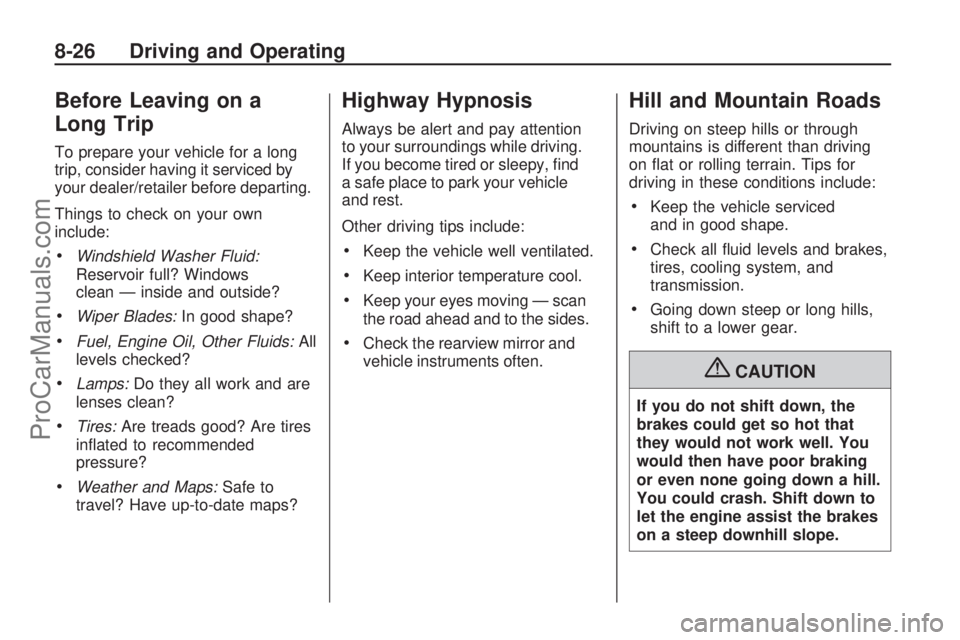
Before Leaving on a
Long Trip
To prepare your vehicle for a long
trip, consider having it serviced by
your dealer/retailer before departing.
Things to check on your own
include:
Windshield Washer Fluid:
Reservoir full? Windows
clean — inside and outside?
Wiper Blades:In good shape?
Fuel, Engine Oil, Other Fluids:All
levels checked?
Lamps:Do they all work and are
lenses clean?
Tires:Are treads good? Are tires
in�ated to recommended
pressure?
Weather and Maps:Safe to
travel? Have up-to-date maps?
Highway Hypnosis
Always be alert and pay attention
to your surroundings while driving.
If you become tired or sleepy, �nd
a safe place to park your vehicle
and rest.
Other driving tips include:
Keep the vehicle well ventilated.
Keep interior temperature cool.
Keep your eyes moving — scan
the road ahead and to the sides.
Check the rearview mirror and
vehicle instruments often.
Hill and Mountain Roads
Driving on steep hills or through
mountains is different than driving
on �at or rolling terrain. Tips for
driving in these conditions include:
Keep the vehicle serviced
and in good shape.
Check all �uid levels and brakes,
tires, cooling system, and
transmission.
Going down steep or long hills,
shift to a lower gear.
{CAUTION
If you do not shift down, the
brakes could get so hot that
they would not work well. You
would then have poor braking
or even none going down a hill.
You could crash. Shift down to
let the engine assist the brakes
on a steep downhill slope.
8-26 Driving and Operating
ProCarManuals.com
Page 182 of 304

Rocking Your Vehicle to
Get It Out
First, turn the steering wheel left and
right to clear the area around the
front wheels. Turn off any stability
system. SeeStabiliTrak
®System on
page 8-19. Then shift back and forth
between REVERSE (R) and a
forward gear, or with a manual
transmission, between FIRST (1) or
SECOND (2) and REVERSE (R),
spinning the wheels as little as
possible. To prevent transmission
wear, wait until the wheels stop
spinning before shifting gears.Release the accelerator pedal
while you shift, and press lightly
on the accelerator pedal when
the transmission is in gear. By slowly
spinning the wheels in the forward
and reverse directions, you will
cause a rocking motion that could
free your vehicle. If that does not get
your vehicle out after a few tries, it
might need to be towed out. If your
vehicle does need to be towed out,
seeTowing Your Vehicle on
page 9-72.
Loading the Vehicle
It is very important to know how
much weight your vehicle can
carry. This weight is called the
vehicle capacity weight and
includes the weight of all
occupants, cargo and all
nonfactory-installed options.
Two labels on your vehicle
show how much weight it may
properly carry, the Tire and
Loading Information label and
the Certi�cation label.
8-30 Driving and Operating
ProCarManuals.com
Page 206 of 304
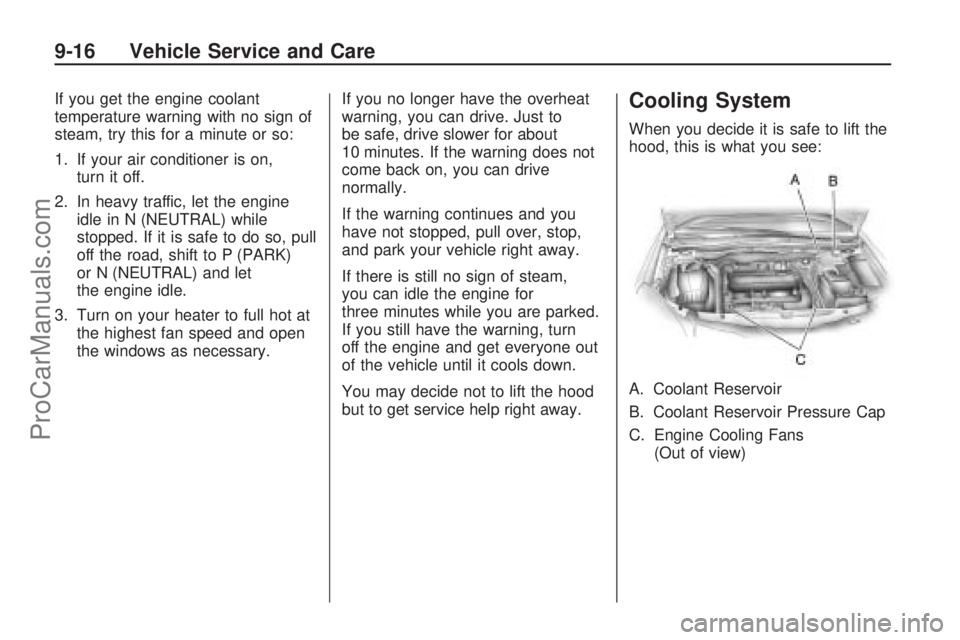
If you get the engine coolant
temperature warning with no sign of
steam, try this for a minute or so:
1. If your air conditioner is on,
turn it off.
2. In heavy traffic, let the engine
idle in N (NEUTRAL) while
stopped. If it is safe to do so, pull
off the road, shift to P (PARK)
or N (NEUTRAL) and let
the engine idle.
3. Turn on your heater to full hot at
the highest fan speed and open
the windows as necessary.If you no longer have the overheat
warning, you can drive. Just to
be safe, drive slower for about
10 minutes. If the warning does not
come back on, you can drive
normally.
If the warning continues and you
have not stopped, pull over, stop,
and park your vehicle right away.
If there is still no sign of steam,
you can idle the engine for
three minutes while you are parked.
If you still have the warning, turn
off the engine and get everyone out
of the vehicle until it cools down.
You may decide not to lift the hood
but to get service help right away.Cooling System
When you decide it is safe to lift the
hood, this is what you see:
A. Coolant Reservoir
B. Coolant Reservoir Pressure Cap
C. Engine Cooling Fans
(Out of view)
9-16 Vehicle Service and Care
ProCarManuals.com
Page 250 of 304
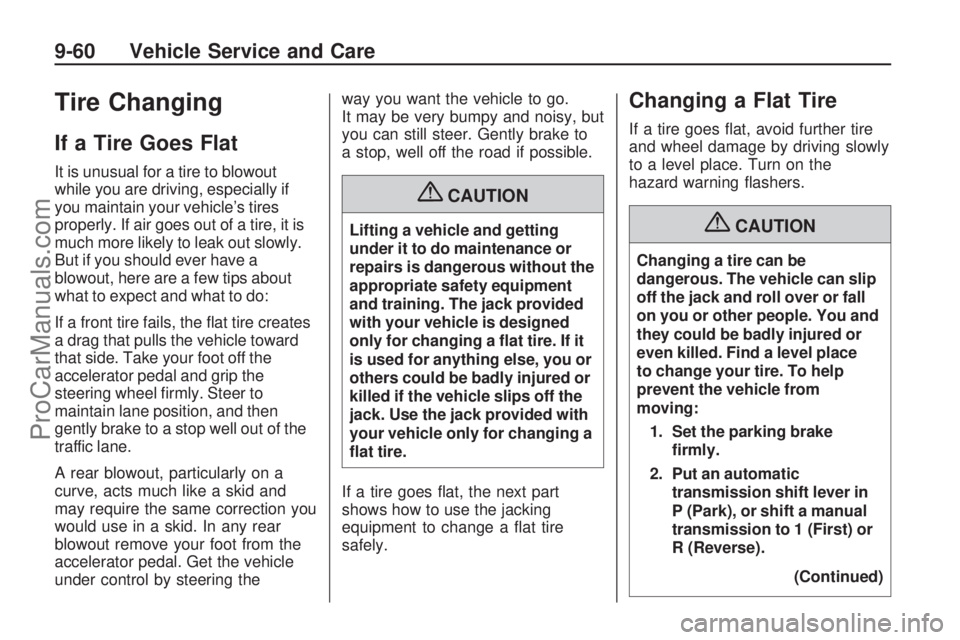
Tire Changing
If a Tire Goes Flat
It is unusual for a tire to blowout
while you are driving, especially if
you maintain your vehicle’s tires
properly. If air goes out of a tire, it is
much more likely to leak out slowly.
But if you should ever have a
blowout, here are a few tips about
what to expect and what to do:
If a front tire fails, the �at tire creates
a drag that pulls the vehicle toward
that side. Take your foot off the
accelerator pedal and grip the
steering wheel �rmly. Steer to
maintain lane position, and then
gently brake to a stop well out of the
traffic lane.
A rear blowout, particularly on a
curve, acts much like a skid and
may require the same correction you
would use in a skid. In any rear
blowout remove your foot from the
accelerator pedal. Get the vehicle
under control by steering theway you want the vehicle to go.
It may be very bumpy and noisy, but
you can still steer. Gently brake to
a stop, well off the road if possible.
{CAUTION
Lifting a vehicle and getting
under it to do maintenance or
repairs is dangerous without the
appropriate safety equipment
and training. The jack provided
with your vehicle is designed
only for changing a �at tire. If it
is used for anything else, you or
others could be badly injured or
killed if the vehicle slips off the
jack. Use the jack provided with
your vehicle only for changing a
�at tire.
If a tire goes �at, the next part
shows how to use the jacking
equipment to change a �at tire
safely.
Changing a Flat Tire
If a tire goes �at, avoid further tire
and wheel damage by driving slowly
to a level place. Turn on the
hazard warning �ashers.
{CAUTION
Changing a tire can be
dangerous. The vehicle can slip
off the jack and roll over or fall
on you or other people. You and
they could be badly injured or
even killed. Find a level place
to change your tire. To help
prevent the vehicle from
moving:
1. Set the parking brake
�rmly.
2. Put an automatic
transmission shift lever in
P (Park), or shift a manual
transmission to 1 (First) or
R (Reverse).
(Continued)
9-60 Vehicle Service and Care
ProCarManuals.com